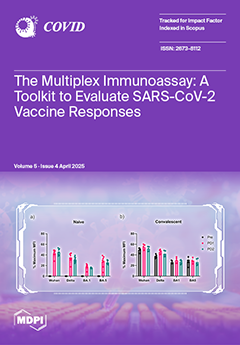Open AccessBrief Report
Detection of SARS-CoV-2 in Ascitic Fluid of Cirrhotic COVID-19 Patients: Case Series and Literature Review
by
Grazia Caci, Andrea Marino, Edoardo Campanella, Ylenia Russotto, Cristina Micali, Natascia Laganà, Aldo Sitibondo, Roberto Filomia, Antonino Botindari, Serena Spampinato, Giuseppe Mancuso, Angelina Midiri, Giovanni Francesco Pellicanò, Giuseppe Nunnari and Emmanuele Venanzi Rullo
Viewed by 1024
Abstract
SARS-CoV-2 has been identified in multiple organs and fluids, including the liver and peritoneal fluid. Gastrointestinal symptoms, such as abdominal pain, diarrhea, nausea, and vomiting, can exacerbate COVID-19 outcomes by contributing to complications, like acid–base imbalances and cardiovascular dysfunction, particularly in patients with
[...] Read more.
SARS-CoV-2 has been identified in multiple organs and fluids, including the liver and peritoneal fluid. Gastrointestinal symptoms, such as abdominal pain, diarrhea, nausea, and vomiting, can exacerbate COVID-19 outcomes by contributing to complications, like acid–base imbalances and cardiovascular dysfunction, particularly in patients with pre-existing conditions. We report three cases of COVID-19 cirrhotic patients with SARS-CoV-2 detected in their ascitic fluid and review the relevant literature on the virus’s presence and clinical significance in peritoneal fluid. These findings underscore diagnostic and prognostic challenges in managing COVID-19 in patients with chronic liver disease and highlight the need for further research to clarify viral dissemination mechanisms and optimize protective measures for healthcare workers during surgical procedures.
Full article





